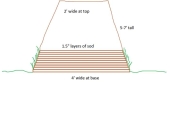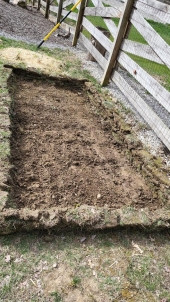
 1
1





SKIP books, get 'em while they're hot!!! Skills to Inherit Property
See me in a movie building a massive wood staircase:Low Tech Lab Movie
 2
2




 1
1




 1
1








 But it could act like a wind break and hugelkultur.....
But it could act like a wind break and hugelkultur.....
SKIP books, get 'em while they're hot!!! Skills to Inherit Property
See me in a movie building a massive wood staircase:Low Tech Lab Movie
 2
2




Mike Haasl wrote:Thanks everyone! I think getting enough newspaper would be nearly as hard as the cardboard, unfortunately.
For the sod cutter, I was hoping to scalp off as little top soil as possible. Could I get away with just removing an inch? Would that get all the grass crowns or do I need to go deeper?
Mike Haasl wrote:
Hester, one suggestion from a fellow gardener was to leave grass in the paths and dig a trench to keep the grass from getting into the beds. Apparently a 3 to 4" deep straight sided trench will keep the grass from going past it. Like a moat of air.

 4
4




 1
1








SKIP books, get 'em while they're hot!!! Skills to Inherit Property
See me in a movie building a massive wood staircase:Low Tech Lab Movie
 1
1








SKIP books, get 'em while they're hot!!! Skills to Inherit Property
See me in a movie building a massive wood staircase:Low Tech Lab Movie








 1
1




Mike Haasl wrote:Thanks John, I do have the offer of a tractor with a tiller. I'm worried that, based on personal experience, the tiller will cut the sod into a bajillion pieces and then some fraction of those pieces will be close enough to the surface to return to life. Then all my new gardeners will have to stay on top of plucking the chunks of sod before they get re-established. On my own large garden we "harvested" a couple wheelbarrows full of small sod pieces. I'm not sure I want to rely on new gardeners to stay on top of that task.
But it would keep all the soil and fertility on the plots so it's definitely an option...
 1
1




SKIP books, get 'em while they're hot!!! Skills to Inherit Property
See me in a movie building a massive wood staircase:Low Tech Lab Movie








 1
1




 4
4




If someone ever makes the Avengers of gardeners, my goal is to make that team!
 3
3




"The rule of no realm is mine. But all worthy things that are in peril as the world now stands, these are my care. And for my part, I shall not wholly fail in my task if anything that passes through this night can still grow fairer or bear fruit and flower again in days to come. For I too am a steward. Did you not know?" Gandolf




SKIP books, get 'em while they're hot!!! Skills to Inherit Property
See me in a movie building a massive wood staircase:Low Tech Lab Movie
 1
1





 1
1




SKIP books, get 'em while they're hot!!! Skills to Inherit Property
See me in a movie building a massive wood staircase:Low Tech Lab Movie
 1
1




If someone ever makes the Avengers of gardeners, my goal is to make that team!
 4
4




 Then we can bring in a few inches of compost with the cost defrayed from the sale of the sod. Then use the tractor and tiller to work in the compost along with any other amendments suggested by a soil test.
Then we can bring in a few inches of compost with the cost defrayed from the sale of the sod. Then use the tractor and tiller to work in the compost along with any other amendments suggested by a soil test.
SKIP books, get 'em while they're hot!!! Skills to Inherit Property
See me in a movie building a massive wood staircase:Low Tech Lab Movie
 2
2




 1
1




 1
1






SKIP books, get 'em while they're hot!!! Skills to Inherit Property
See me in a movie building a massive wood staircase:Low Tech Lab Movie
 1
1




Permies is awesome!!!
 3
3




$10.00 is a donation. $1,000 is an investment, $1,000,000 is a purchase.
 1
1




 2
2




SKIP books, get 'em while they're hot!!! Skills to Inherit Property
See me in a movie building a massive wood staircase:Low Tech Lab Movie

|
Let's get him boys! We'll make him read this tiny ad!
Learn Permaculture through a little hard work
https://wheaton-labs.com/bootcamp
|





